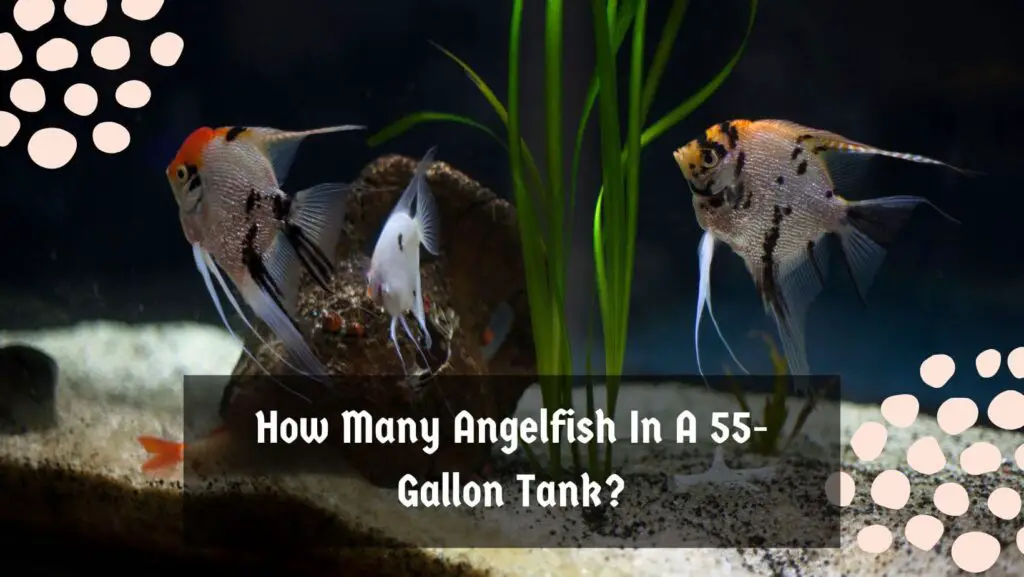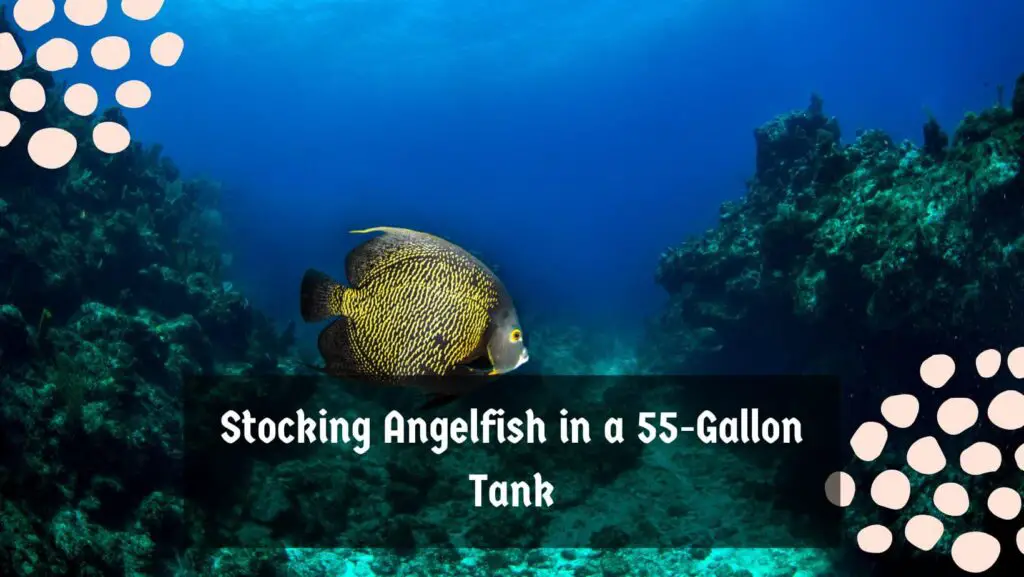
If you already have a 50-gallon tank, you should know the stocking density you can have in it, especially when it comes to housing big peaceful ‘angelfish. In aquariums, Angelfish are known for their graceful appearance & vibrant color.
Therefore if you are considering adding Angelfish, you must provide them with a suitable environment and accommodation. One thing for sure is that a 55-gallon tank can accommodate small groups of Angelfish with other compatible tank mates.
However, how many Angelfish in a 55-gallon tank can live peacefully depends upon many factors. In this article, I will discuss how many Angelfish are in a 50-gallon tank and the factor you need to consider when housing X number of Angelfish, along with individual space requirements, compatible tanks, maintenance tips, & more.
Before I tell you all this, it is important to learn the answer to the question: ‘How many angelfish in a 55-gallon tank?’.
How Many Angelfish In A 55-Gallon Tank?

You can have 3-4 pairs of Angelfish in a 55-gallon tank or even more, depending upon its layout & decoration. As per the rule, you should provide 10 gallons of water space for each Angelfish in a tank.
Also, each individual must have its territorial boundaries, hiding spots, & share of food. Plus, many other factors may influence the stocking number of Angelfish for a 55-gallon tank, like fish size, potential tank mates, and individual preferences.
The most important consideration is the space required for each Angelfish. To ensure their well-being, you should provide them ample room to swim & establish their territory. Angelfish are known to grow to various sizes, with an adult size ranging between 6-8 inches in height and 8-10 inches in length.
Consider their height, as providing a vertical space for them to swim comfortably is crucial. In addition, you should note that these elegant fish tend to have distinct triangular shapes with long fins that trail behind them as they gracefully navigate the water.
This behavior is often characterized by territorial nature as they establish & defend their areas within the tank. You need to understand the size and behavior to determine the amount of Angelfish you can have for a 55-gallon tank.
If you want to calculate the minimum space requirement for Angelfish, you should follow a general guideline, as I told you earlier. You should allocate at least 10 gallons per Angelfish, allowing them enough roof room to establish territories and reduce the likelihood of aggression.
Since a 55-gallon tank can accommodate up to 6 fish comfortably, remember to choose carefully by considering their compatibility as well.
It is important to note that individual Angelfish may have unique needs & behavior, so make sure to monitor their interaction closely. Below are some related topics that may worth your time to read:
| How Many Angelfish Can You Keep In A 40-Gallon Tank? |
| How Many Angelfish In A 20-Gallon Tank |
| How Many Angelfish In A 30-Gallon Tank |
Stocking Angelfish in a 55-Gallon Tank

Maximum Number of Angelfish
As I told you earlier, you can easily house 56 angelfish in a 55-gallon tank, but it also depends upon factors. As per the general rule, you should have a maximum of 4 angelfish in that setup if planning for breeding.
If you are not planning for breeding but are only looking to set up a community tank, consider allowing each Angelfish sufficient space to minimize overcrowding risk. If you adhere to this guideline, you can keep your Angelfish happy and healthy for longevity.
We have also shared an in-depth article on ‘How long do freshwater angelfish live‘ where you can learn about tips & strategies for their longevity. Always note that overcrowding can lead to stressful territorial disputes and compromised water quality, which will again negatively impact the overall health of your Angelfish.
Compatible Tank Mates
Even though Angelfish are known to coexist with various species in a 55-gallon tank, not all of them are suitable due to the differences in behavior & compatibility. If you want to avoid bad tankmates for Angelfish, consider reading this article.
We have also shared an in-depth article on the seven best tankmates for Angelfish, which might suit your community tank. You must also do your research and select tankmates that can peacefully cohabit in the same aquarium.
Some of the suitable tankmates for Angelfish that I find very enticing to add to a 55-gallon tank include tetras, gouramis, Rasboras, and corydoras catfish. We’ve already shared articles on these two species’ compatibility with Angelfish.
You can check out our articles on ‘Can Angelfish live with gouramis‘ & ‘Can Angelfish live with Tetras.’ All these species are known to exhibit compatible behavior. Also, they tend to have a similar water parameter requirement creating a harmonious environment for all inhabitants.
If you have a 55-gallon tank, I recommend a mix of these species that add visual interest & variety to your aquarium. However, also make sure to introduce the tank mates gradually and give them an appropriate time to acclimate. You should monitor their interaction & always be prepared to make necessary adjustments when required.
Maintenance & Care Tips
Water Quality & Filtration
Having too many fish in a 55-gallon tank will degrade the water quality. Therefore, maintaining optimal water quality is very important for the health of your Angelfish. I recommend you do regular water changes that can keep ammonia & nitrate levels in check to ensure a clean and stable environment for all inhabitants in the tank.
You should also perform a water change of approximately 20% every two weeks. Also, it would help if you considered investing in a quality filtration system appropriate for a 50-gallon tank.
A reliable filtration system is very important and helpful in removing waste, excess nutrients, and harmful toxins from the water, promoting a healthy & balanced ecosystem for your Angelfishes. Also, choose a filter that provides mechanical, biological, and chemical filtration for optimal water quality.
Feeding Requirements
Since Angelfish are known to be omnivorous, meaning they can consume both plant matter and small aquatic organisms, you should know, ‘Do Angelfish eat other fish.’ It’s uncommon for them to eat other small fishes except for invertebrates and small worms.
However, they may eat small fish under stress or with no alternative food source. In general, you should provide a balanced diet for their well-being & vitality. Many types of high-quality angelfish pellets & flakes are available as a staple diet for your pets.
However, I recommend you look for varieties that contain a balanced combination of protein, vitamins, and minerals. It is recommended to feed Angelfish twice a day using commercially available high-quality pellets or flake while offering a small portion of supplements like live or frozen foods such as shrimp, daphnia, and bloodworms.
Also, offer small portions they can consume within a few minutes to avoid poor water quality. Uneaten food and overfeeding can lead to poor water quality, so it’s best to stick to small portion control. Remember to supplement their diet with live or Frozen Food as these are important additional nutrients that mimic Angelfish’s natural diet in the wild.
Monitoring & Adjusting the Angelfish Population
It is also very crucial that you pay attention to the regular observation of your Angelfish to detect any signs of stress or illness. If your Angelfish is healthy, it will exhibit active swimming, vibrant color, and an appetite for food.
However, if you notice any abnormality in your fish, make sure to investigate further and address the issue promptly. In case of overpopulation or aggression, you will have to provide adjustments.
If you think the tank has become overcrowded, Angelfish will start to feel stressed, leading to territorial disputes and health issues. Therefore make sure you monitor this kind of behavior of your Angelfish closely and intervene as soon as possible if necessary.
Some popular options for resolving overpopulation or aggression include rehoming excess fish to a suitable environment or setting up additional tanks to separate aggressive individuals.
You can also utilize a tank divider to create a separate territory within the same tank. You should choose the right approach Depending on the specific circumstances and available resources.
Conclusion
I have given my best to give you an in-depth knowledge of ‘how much angelfish in a 55-gallon tank’ can accommodate. After knowing the ideal stocking number you can have in a 50-gallon tank, ensure you provide them with an ideal environment that mimics their natural habitat.
Also, note some careful considerations or factors into your account, like population, individual space requirement, and compatible mates. Following all the guidelines mentioned in this article can create a thriving & harmonious aquatic ecosystem.
Since a happy & healthy Angelfish is a site to behold, you must conduct regular maintenance & monitor their well-being to continue enjoying the joy these fishes bring to any aquarium enthusiast. If you find this article helpful, then consider sharing it.
Your share will help many people learn how ‘how many angelfish in a 50-gallon tank’ can live without signs of aggression or territorial dispute. Check my other helpful guide on angelfish care, tankmates, and facts. See you in the next post, till then, take care & goodbye.

